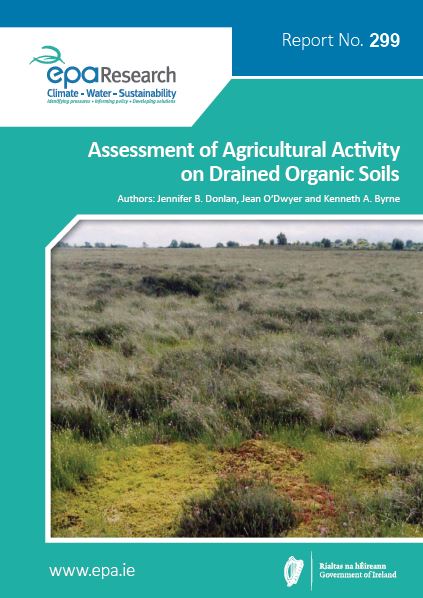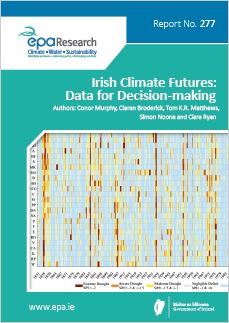Latest Climate Change reports

Research 314: Deepening Public Engagement on Climate Change: Lessons from the Citizens’ Assembly
Authors: Laura Devaney, Diarmuid Torney, Pat Brereton and Martha Coleman, April 2020
Year: 2020
The Irish Citizens’ Assembly afforded 99 citizens the time, space and structure to deliberate on some of the most important issues facing Irish society and politics. The 13 climate recommendations agreed on by the citizens in consideration of “How the State can make Ireland a leader in tackling climate change” were significantly more radical than many expected. They encompassed a suite of sectors, solutions and policy actions.

Research 310: EC-Earth Global Climate Simulations: Ireland’s Contributions to CMIP6
Authors: Paul Nolan and Alastair McKinstry , March 2020
Year: 2020
This report provides an overview of future global climate projections as simulated by the EC-Earth Earth system model. The global climate simulations described in this report constitute Ireland’s contribution to the Coupled Model Intercomparison Project (CMIP) (phase 6) (CMIP6) and will be included for assessment in the United Nations Intergovernmental Panel on Climate Change (IPCC) Sixth Assessment Report (AR6)

Research 305: BRIAR: Biomass Retrieval in Ireland using Active Remote sensing
Authors: Stuart Green, Shafique Martin, Saeid Gharechelou, Fiona Cawkwell and Kevin Black, December 2019
Year: 2019
Hedgerows are an important feature of the Irish landscape. They perform multiple functions, acting as boundary markers, reservoirs of biodiversity, controlling run-off and they store carbon in above-ground biomass. The purpose of this study was to examine the use of an active remote sensing tool, imaging radar, to estimate biomass in hedgerows.

Research 304: Scaling Soil Greenhouse Gas Emissions to the National Level
Authors: Mike G. Whitfield, Mohamed Abdalla, Giuseppe Benanti, William Burchill, Dru Marsh, Bruce Osborne, Brendan Roth, Matthew Saunders, Pete Smith and Mike Williams, December 2019
Year: 2019
This project was concerned with improving the national inventory of GHG emissions from Irish soils. The IPCC's Tier 2 and 3 methodologies were used, effectively upscaling regional data on N2O and CO2 to the national level, through a combined process-based model and geographic information system (GIS) approach.

Research 302: Fossil Fuel Lock-in in Ireland: How Much Value Is at Risk?
Authors: Celine McInerney, Conor Hickey, Paul Deane, Joseph Curtin and Brian Ó Gallachóir, December 2019
Year: 2019
The European emissions reduction policy is clear and calls for the energy sectors, particularly the electricity sector, to be carbon neutral before 2050. The objective of this study is to examine how the decarbonisation of the power system will impact the investment case for both electricity generation and infrastructure assets.

Research 301: Adaptive Responses to Climate Impacts (ARC)
Authors: Justin Doran, Thomas McDermott, Paul Kilgarriff, Swenja Surminski and Mauricio Perez Alaniz, November 2019
Year: 2019
Climate change is likely to lead to physical changes in temperature and precipitation and sea level rise, and Ireland is already experiencing the effects of climate change on its weather patterns. This project identifies several interacting factors that should be considered in designing efficient climate change adaptation strategies.

Research 300: Climate Change in Irish Media
Authors: Eileen Culloty, Alan Smeaton, Jane Suiter, Padraig Murphy, Pat Brereton, Dian Zhang and Dave Robbins , November 2019
Year: 2019
Research indicates that public concern about climate change is largely derived from media consumption. This project investigated coverage trends on climate change across print, broadcast and online media in order to make recommendations for climate change communicators.

Research 299: Assessment of Agricultural Activity on Drained Organic Soils
Authors: Jennifer B. Donlan, Jean O’Dwyer and Kenneth A. Byrne, November 2019
Year: 2019
Peatlands play a vital role in the carbon cycle in terms of carbon storage and biosphere–atmosphere exchange of greenhouse gases. Drainage and conversion to agriculture dramatically alters these processes and transforms the ecosystem from a carbon sink to a carbon source. A key prerequisite for assessing the magnitude of such emissions is to estimate the area of peatland under agricultural use, in this case cultivation.

Research 287: Catalysing and Characterising Transition
Authors: Geraint Ellis, Therese Hume, John Barry and Robin Curry, September 2019
Year: 2019
This synthesis report presents the main findings from a desk study on Catalysing and Characterising Transition (CCTransitions), which was funded by the Environmental Protection Agency (EPA).

Research 288: A Review of Livestock Methane Emission Factors
Authors: Donal O’Brien and Laurence Shalloo, September 2019
Year: 2019
Teagasc and University College Dublin, with support from the Environmental Protection Agency (EPA) inventory team, reviewed the livestock methane emission factors used in the national greenhouse gas inventory approach for the agriculture sector and assessed potential reduction strategies.

Research 286: CON+AIR: Addressing Conflicts of Climate and Air Pollution
Authors: Eoin Ó Broin, Andrew Kelly, Gabriela Sousa Santos, Henrik Grythe and Luke Kelleher, September 2019
Year: 2019
The CON+AIR project presents two counterfactual scenarios for emissions and concentrations of air pollutants in Ireland in the year 2030.

Research 277: Irish Climate Futures: Data for Decision-making
Authors: Conor Murphy, Ciaran Broderick, Tom K.R. Matthews, Simon Noone and Ciara Ryan, June 2019
Year: 2019
The realisation of a climate-resilient Ireland over the coming decades depends on decisions taken at all scales to adapt to climate change. Good decisions depend on the types and quality of information used to inform planning. Building resilience requires the diversification of the types of information used for understanding past and future climate variability and change, and a better understanding of the range of plausible changes.

Climate Research Coordination Group: First Report on Activities: June 2017 - December 2018
Authors: This report has been prepared by the Climate Research Coordination Group with the assistance of Flannery Nagel Environmental Ltd. Edited by Frank McGovern, Alice Wemaere and Lisa Sheils (EPA). May 2019, May 2019
Year: 2019
This first report presents a summary of the Climate Research Coordination Group’s activities during an 18-month period from June 2017 to December 2018.

Research 266: Ground-based Remote-sensing Synergy for Cloud Properties and Aerosol-Cloud Interactions
Authors: Jana Preißler, Giovanni Martucci and Colin D. O’Dowd, February 2019
Year: 2019
Clouds and aerosols play an important part in climate processes; however, their interactions are not well understood. To study the effect of both natural marine and anthropogenic aerosols on clouds and cloud optical properties we looked at a mix of information from remote-sensing and in situ instruments from more than 6 years.

Research 265: Challenges of Transformative Climate Change Adaptation: Insights from Flood Risk Management
Authors: Darren Clarke and Conor Murphy., January 2019
Year: 2019
Increased attention is now being given to the need for transformative change in dealing with flood risks. This report addresses the lack of knowledge about the challenges associated with attempting transformative change, by drawing on findings from 11 flood risk management case studies across four European countries (Austria, France, Ireland and the Netherlands).

Research 263: Reflecting on Adaptation to Climate Change: International Best Practice Review and National MRE and Indicator Development Requirements.
Authors: Kathrin Kopke, Evanna Lyons, Ellen MacMahon, Barry O’Dwyer and Jeremy Gault., November 2018
Year: 2018
Adaptation Preparedness Indicators for Ireland aims to identify draft adaptation indicator sets. The project carried out a review of international best practice to ascertain criteria and constraints relevant to adaptation indicator development in Ireland.

Research 258: The Development of an Irish Climate Information Platform (ICIP) - Phase 3 (2015-2017)
Authors: Barry O’Dwyer, Mohammad Hashemi and Jeremy Gault, September 2018
Year: 2018
The global climate is changing as a result of human influences; the impacts of these changes are already being felt across all continents and oceans and are expected to continue and intensify for many decades to come.

Research 250: Vulnerability Assessment of Peatlands: Exploration of Impacts and Adaptation Options in Relation to Climate Change and Extreme Events (VAPOR)
Authors: Florence Renou-Wilson and David Wilson, September 2018
Year: 2018
The climate changes predicted for Ireland by the end of the 21st century will have significant impacts on drained, rewetted and natural peatland systems. The VAPOR project was established to inform a transition to a climate-resilient Ireland by providing science-based information on the vulnerability of peatlands to climate change, including extreme weather events.

Research 257: An Operational Climate Information Platform for Ireland: Summary Report
Authors: Alastair McKinstry and Eoin McHugh, August 2018
Year: 2018
Information on climate change and options for adaptation can be complex and inaccessible to key stakeholders and decision makers. This project has developed an Operational Climate Information Platform (OCIP) to disseminate the current data and guidance on climate change for Ireland. The OCIP is scalable, maintainable and can be continuously updated with new data that are generated from operational observation systems and research.

Research 256: National Preparedness to Adapt to Climate Change: Analysis of State of Play
Author: Margaret Desmond, June 2018
Year: 2018
The goal of international and national climate adaptation policy is the transition to a low-carbon, climate-resilient society and economy. This new assessment interrogates in detail Ireland’s preparedness for adaptation action, with a focus on seven key areas related to the adaptation plan-making process.